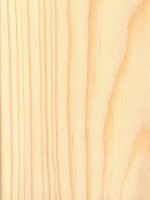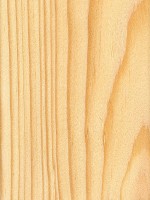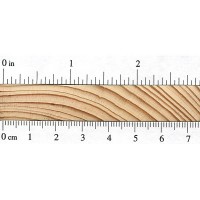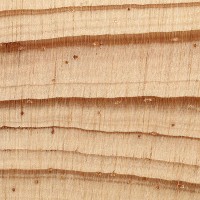 |
Common Name(s): Sand Pine Scientific Name: Pinus clausa Distribution: Southeastern United States (Florida and coastal Alabama) Tree Size: 16-30 ft (5-9 m) tall, 1 ft (.3 m) trunk diameter Average Dried Weight: 34 lbs/ft3 (545 kg/m3) Specific Gravity (Basic, 12% MC): .46, .55 Janka Hardness: 730 lbf (3,250 N) Modulus of Rupture: 11,600 lbf/in2 (80.0 MPa) Elastic Modulus: 1,410,000 lbf/in2 (9.72 GPa) Crushing Strength: 6,920 lbf/in2 (47.7 MPa) Shrinkage: Radial: 3.9%, Tangential: 7.3%, Volumetric: 10.0%, T/R Ratio: 1.9 |
Color/Appearance: Heartwood is reddish brown, wide sapwood is yellowish white.
Grain/Texture: Straight grained with a fine to medium texture.
Endgrain: Large resin canals, numerous and evenly distributed, mostly solitary; earlywood to latewood transition abrupt, color contrast relatively high; tracheid diameter medium-large.
Rot Resistance: The heartwood is rated as moderate to low in decay resistance.
Workability: Overall, Sand Pine works fairly well with most tools, though the resin can gum up tools and clog sandpaper. Sand Pine glues and finishes well.
Odor: Has a distinct smell that is shared among most species in the Pinus genus.
Allergies/Toxicity: Working with pine has been reported to cause allergic skin reactions and/or asthma-like symptoms in some people. See the articles Wood Allergies and Toxicity and Wood Dust Safety for more information.
Pricing/Availability: Generally only larger trees are harvested for lumber, with most specimens being smaller shrubs. It is sold and mixed interchangeably with other species as Southern Yellow Pine, which is widely available as a construction lumber for a modest price.
Sustainability: This wood species is not listed in the CITES Appendices, but is reported by the IUCN as being near threatened. Technically it doesn’t meet the criteria of a vulnerable or endangered species, but is reported to be susceptible to intense forest fires; there has been no evidence showing a decline in population as of yet.
Common Uses: Bridges, beams, poles, railroad ties, etc. It’s also used for making plywood, wood pulp, and veneers.
Comments: Sand Pine is technically considered to be in the group of southern yellow pines, though it is a very minor species, and is typically only shrub-sized.
- Austrian Pine (Pinus nigra)
- Caribbean Pine (Pinus caribaea)
- Eastern White Pine (Pinus strobus)
- Jack Pine (Pinus banksiana)
- Jeffrey Pine (Pinus jeffreyi)
- Khasi Pine (Pinus kesiya)
- Limber Pine (Pinus flexilis)
- Loblolly Pine (Pinus taeda)
- Lodgepole Pine (Pinus contorta)
- Longleaf Pine (Pinus palustris)
- Maritime Pine (Pinus pinaster)
- Ocote Pine (Pinus oocarpa)
- Patula Pine (Pinus patula)
- Pinyon Pine (Pinus edulis)
- Pitch Pine (Pinus rigida)
- Pond Pine (Pinus serotina)
- Ponderosa Pine (Pinus ponderosa)
- Radiata Pine (Pinus radiata)
- Red Pine (Pinus resinosa)
- Scots Pine (Pinus sylvestris)
- Shortleaf Pine (Pinus echinata)
- Slash Pine (Pinus elliottii)
- Spruce Pine (Pinus glabra)
- Sugar Pine (Pinus lambertiana)
- Sumatran Pine (Pinus merkusii)
- Table Mountain Pine (Pinus pungens)
- Western White Pine (Pinus monticola)
- Virginia Pine (Pinus virginiana)







